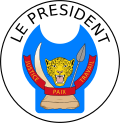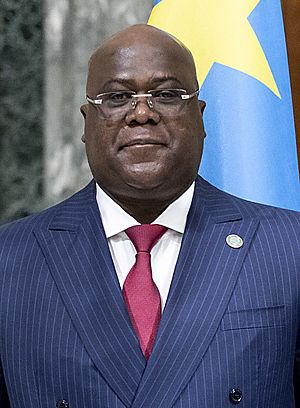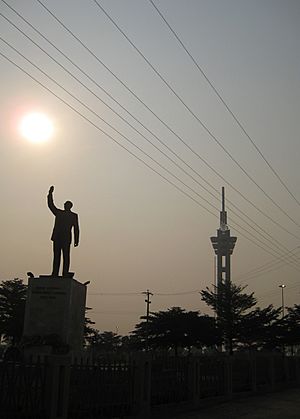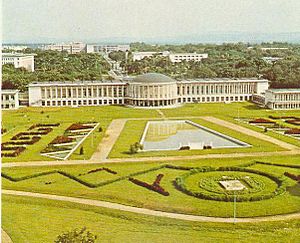President of the Democratic Republic of the Congo facts for kids
Quick facts for kids President of theDemocratic Republic of the Congo |
|
|---|---|

Presidential Standard
|
|

Presidential Seal
|
|
| Style | His Excellency |
| Residence | Palais de la Nation, Kinshasa |
| Term length | 5 years,
renewable once
|
| Constituting instrument | Constitution of the Democratic Republic of Congo (2006) |
| Formation | 30 June 1960 |
| First holder | Joseph Kasavubu |
| Deputy | President of the Senate |
| Website | Official website of the President of the DRC: https://presidence.cd |
The President of the Democratic Republic of the Congo is the country's head of state. This means they are the main leader and symbol of the nation. The president is also the commander-in-chief of the country's armed forces.
The role of president in the DRC began with the first constitution in 1960. Over the years, the president's powers have changed a lot. Sometimes, the president shared power with a prime minister. At other times, the president held almost all the power.
Today, under the current constitution, the president is the highest official in a semi-presidential system. This system combines elements of both presidential and parliamentary governments. The president is protected by the Republican Guard.
Joseph Kabila was president until Félix Tshisekedi was elected in December 2018. Mr. Tshisekedi officially took office on January 24, 2019.
Contents
Understanding Presidential Powers
The DRC's government system is similar to France's. Even though the prime minister and parliament make many laws, the president has a lot of influence. The president holds the highest office in the country.
Choosing the Prime Minister
The president chooses the prime minister. However, the president must pick someone from the political party or group that has the most seats in parliament. If there isn't a clear majority, the president can choose someone who has 30 days to try and form a group of parties that will work together.
The prime minister and their team (called the cabinet) must then show their plans to the National Assembly. The Assembly must approve these plans with a majority vote. Only the National Assembly can remove the prime minister's government.
- When the president and the National Assembly have different political views, it's called "cohabitation." In this situation, the president's power is less because they need the prime minister and Assembly to agree with them. However, the president usually leads the country's foreign policy.
- When the president and the National Assembly agree, the president can be more active in directing government policy. The prime minister might be replaced if the government becomes unpopular.
Key Responsibilities of the President
The president has several important duties:
- They make sure the constitution is followed and that the government works properly.
- They protect the country's independence, land, and power.
- They ensure that international agreements are respected.
- The president appoints the prime minister and, with the prime minister's advice, appoints and removes other government members.
- They lead meetings of the Council of Ministers (the cabinet).
- They officially announce new laws and issue special orders.
- They give power to elected governors and vice-governors in the provinces.
- The president appoints, suspends, and removes many important officials. This includes ambassadors, military officers, high-ranking civil servants, and judges.
- They are the commander-in-chief of the armed forces.
- The president gives out national awards.
- They can declare a state of emergency if the country is in danger.
- They can declare war, but only with permission from both parts of parliament.
- The president can grant pardons or reduce sentences for people who have committed crimes.
- They appoint ambassadors to other countries and welcome foreign ambassadors to the DRC.
- The president helps shape national policy, especially in defense, security, and foreign affairs.
- The president can ask parliament to review a law again, but only once for each law.
Who Can Be President?
Article 72 of the Congolese constitution sets out the rules for becoming president. A person must be a natural-born citizen of the Democratic Republic of the Congo. This means they must belong to one of the original ethnic groups that formed the country at its independence.
The person must also be at least 30 years old. They must not have any legal issues that would stop them from holding public office.
What Happens if the President Leaves Office?
Articles 75 and 76 of the constitution explain what happens if the president dies or resigns. The Constitutional Court officially announces that the position is empty.
Then, the President of the Senate becomes the temporary president. The Independent Electoral Commission must then organize new elections. These elections must happen between 60 and 90 days after the position is declared empty.
Presidential Locations
The official office of the president is the Palais de la Nation (Palace of the Nation) in Kinshasa. The official home of the president is the Camp Tshatshi Palace in Kinshasa. However, it has not been used since 1997.
Other places linked to the president include:
- The Palais de Marbre: This palace hosts official foreign guests.
- The Domaine de la Rwindi in Goma, Nord-Kivu.
How Presidents Are Elected
Under the 2006 constitution, the president is chosen directly by the people. They serve a five-year term and can be re-elected only once. Joseph Kabila was the first president elected under these rules in 2006.
After being elected, the president takes part in a special ceremony called an investiture.
2023 Election Results
| Candidate | Party | Votes | % | |
|---|---|---|---|---|
| Félix Tshisekedi | Union for Democracy and Social Progress | 13,058,962 | 73.47 | |
| Moïse Katumbi | Together for the Republic | 3,256,572 | 18.32 | |
| Martin Fayulu | Commitment to Citizenship and Development | 875,336 | 4.92 | |
| Adolphe Muzito | New Momentum | 200,800 | 1.13 | |
| Soborabo Radjabho Tebabho | Congolese United for Change | 70,099 | 0.39 | |
| Denis Mukwege | Independent | 39,639 | 0.22 | |
| Aggrey Ngalasi Kurisini | Independent | 37,201 | 0.21 | |
| Constant Mutamba | Revolutionary Progressive Dynamic | 36,197 | 0.20 | |
| Jean-Claude Baende | Independent | 25,584 | 0.14 | |
| Delly Sesanga | Flight | 17,785 | 0.10 | |
| Loli Nkema Liloo Bokonzi | Independent | 17,046 | 0.10 | |
| Patrice Majondo Mwamba | Independent | 15,793 | 0.09 | |
| Marie-Josée Ifoku | Independent | 15,266 | 0.09 | |
| Matata Ponyo Mapon | Leadership and Governance for Development | 14,181 | 0.08 | |
| André Masalu Anedu | Independent | 13,974 | 0.08 | |
| Floribert Anzuluni | Independent | 13,707 | 0.08 | |
| Noël Tshiani | Independent | 9,276 | 0.05 | |
| Seth Kikuni | Independent | 8,621 | 0.05 | |
| Justin Mudekereza Bisimwa | Independent | 7,573 | 0.04 | |
| Joëlle Bile Batali | Independent | 6,911 | 0.04 | |
| Franck Diongo | Progressive Lumumbist Movement | 6,780 | 0.04 | |
| Tony Bolamba | Independent | 6,307 | 0.04 | |
| Rex Kazadi Kanda | Independent | 5,757 | 0.03 | |
| Georges Buse Falay | Independent | 5,288 | 0.03 | |
| Enoch Ngila | Independent | 5,156 | 0.03 | |
| Théodore Ngoy | Independent | 4,132 | 0.02 | |
| Total | 17,773,943 | 100.00 | ||
| Valid votes | 17,773,943 | 99.85 | ||
| Invalid/blank votes | 26,252 | 0.15 | ||
| Total votes | 17,800,195 | 100.00 | ||
| Registered voters/turnout | 41,738,628 | 42.65 | ||
| Source: CENI as amended by the Constitutional Court | ||||
See also
 In Spanish: Presidente de la República Democrática del Congo para niños
In Spanish: Presidente de la República Democrática del Congo para niños
- Government of the Democratic Republic of the Congo
Historical Information:
- Vice-Presidents of the Democratic Republic of the Congo
- Colonial Heads of Congo
- Zaire





